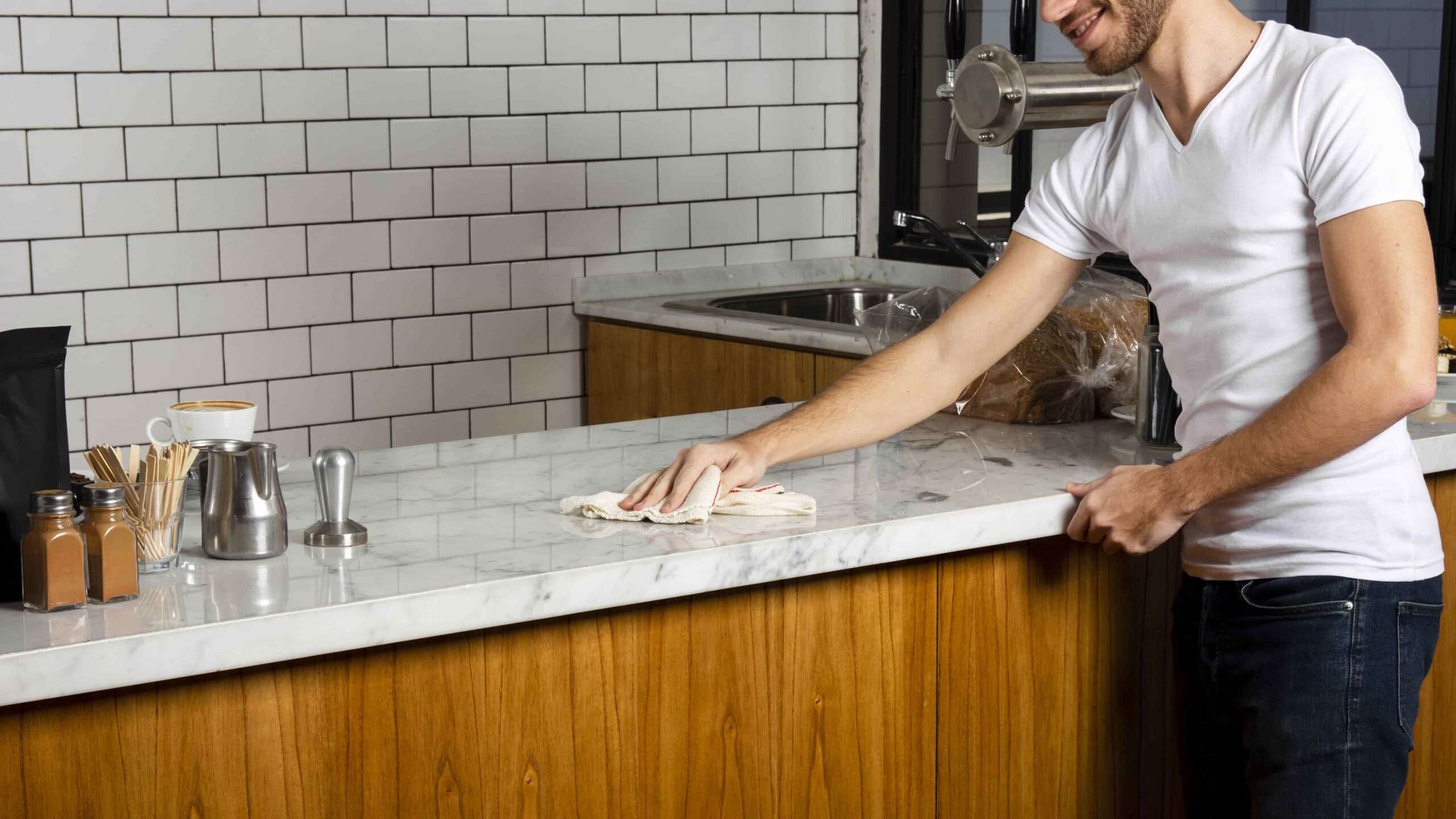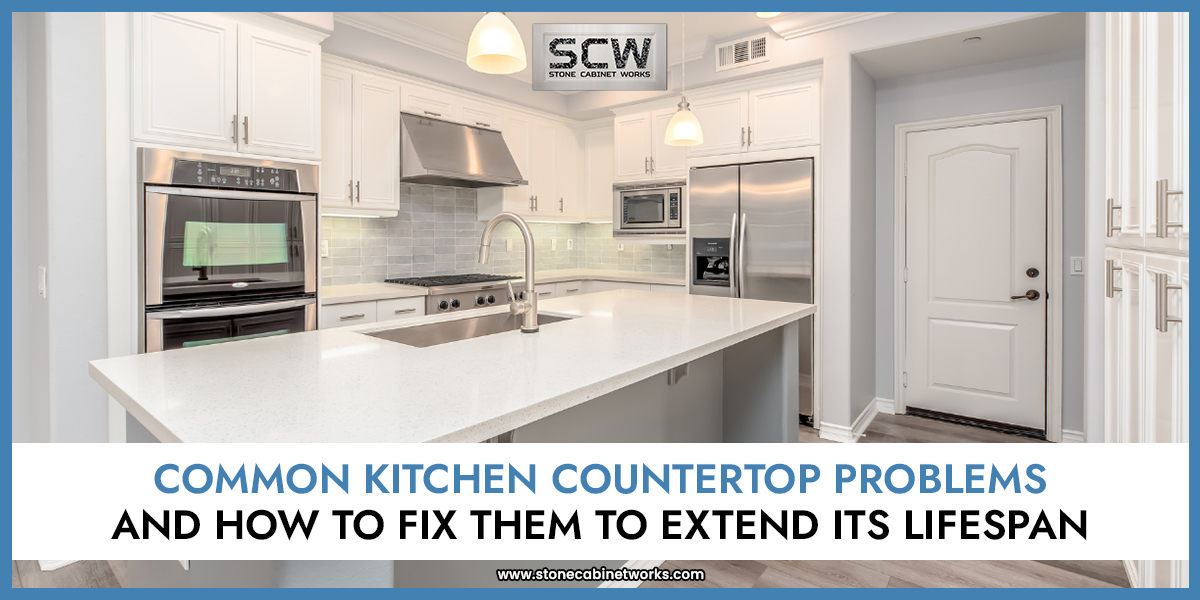Your kitchen countertops are the real hero of your kitchen as it enduring daily spills, heat, and heavy use. Countertops are durable but they aren’t something unbeatable as over the time even the toughest materials can show signs of wear and tear. Fortunately, the good news is that many common countertop problems can be fixed, extending their lifespan and keeping your kitchen looking its best. If you are one of the Illinois homeowners, understanding these issues and their solutions can save you time and money. So what are you waiting? Read on this blog to know the common problems and how to fix those problems to extend the longetivity of your countertop.
4 Common Countertop Problems and Ways to Fix Them
1. Stains
Stains are one of the most common countertop problems, especially on porous materials like natural stone such as granite, marble, quartzite or even some lighter-colored quartz. Coffee, wine, acidic foods like lemon juice, vinegar, oil and even hard water can leave light colored marks on the countertop. This happens because porous materials absorb liquids, allowing them to penetrate the surface. Even sealed stone can stain if the sealant wears off or if spills are left too long.
Ways to Fix Stains
-
Wipe Immediately

For fresh or less spills, wipe the countertop immediately with a clean cloth. If the spill covers more coverage in that case don’t wipe it directly as this can spread the stain further, for that just blot the spill and then wipe up the countertop surface.
-
General Cleaning
For everyday grime, use a pH-neutral cleaner specifically designed for your countertop material. Avoid harsh abrasives or acidic cleaners, especially on natural stone, as they can strip the sealant.
-
Poultice for Stubborn Stains (Natural Stone)
This is your best friend for deep-set stains. A poultice is a paste that draws the stain out of the stone. You can buy commercial poultices or make your own with absorbent material like baking soda, flour, or paper towels mixed with a chemical agent specific to the stain type such as hydrogen peroxide for organic stains, acetone for oil-based stains. Apply, cover with plastic wrap, tape down, and let sit for 12-24 hours. Then remove the paste and clean. Repeat if necessary.
-
Specific Stain Removal (Quartz/Solid Surface)
Use a mild abrasive cleaner or rubbing alcohol can tackle tough marks.
-
Prevention is Key
Because of the varied climate in Illinois, humidity levels can fluctuate. Ensure your natural stone countertops are properly sealed, and re-seal annually or as recommended by your installer. This creates a barrier against stains.
2. Dull Spots
Dull Spots are also known as etching. Etching is a dull, lighter spot that appears on acid-sensitive materials like marble, limestone, and sometimes certain types of granite or engineered quartz. It’s not a stain but a chemical reaction that damages the surface finish. This thing happens when your countertop comes into the contact with acidic substances such as lemon juice, vinegar, or wine that literally eats away your stone finish, which results in dull mark. Always use cutting boards, especially when prepping acidic foods and never use acidic cleaners on marble or other acid-sensitive stones to prevent these type of marks.
Ways to Fix It
-
Minor Etches (Natural Stone)
For very light etches, sometimes polishing with a specialized stone polishing compound can help restore some shine. This is a temporary fix and may not completely remove etch.
-
Professional Help
For significant etching, professional stone restoration is usually required. They can re-polish the surface to restore its original finish.
3. Chips and Cracks
Chips are small pieces broken off the edge or surface and cracks are more significant breaks extending across the countertop. This can happens due to accidents like dropping heavy objects, impact from pots and pans, or stress from improper installation can cause chips and cracks. Expansion and contraction due to temperature swings can exacerbate existing weaknesses.
Ways to Fix It
-
Small Chips (Granite/Quartz)
For minor chips, clear epoxy or color-matched repair kits are available at hardware stores or from countertop suppliers which can often fill the void. You just need to carefully clean the area, apply the filler, smooth it, and allow it to cure.
-
Cracks
For hairline cracks which are common in granite and quartz, these can be filled with clear epoxy or a repair kit to prevent them from spreading. For larger cracks, especially on natural stone, professional repair is needed. They can use specialized resins and techniques to bond the crack and make it less noticeable. Small cracks in laminate or solid surface might be patched with repair compounds, but larger cracks often required replacement of that section or the entire countertop.
4. Dullness
Over time, even sealed countertops can lose their initial shine due to wear, improper cleaning, or chemical reactions. The surface of the countertop appears hazy, dull, or lacks its original reflectivity. This can happen due to abrasive cleaners, everyday wear, residue build-up from soap, or the breakdown of sealant.
How to Fix It
-
Thorough Cleaning

Start by giving your countertops a deep clean with a pH-neutral cleaner designed for your material. Rinse thoroughly to remove all residue.
-
Polishing (Natural Stone)
For granite and other natural stone, you can use a stone polish designed to enhance shine and protect the surface. Apply according to product directions.
-
Resealing (Natural Stone)
If your stone is natural, a fresh coat of sealant can often restore some of its luster while also protecting against future stains.
-
Professional Polishing
For significant dullness or scratches, a professional stone fabricator can re-polish the surface to restore its original finish.
How to Extend the Countertop Lifespan?
-
Regular Cleaning
Consistent, gentle cleaning with the right products is your first priority to prevent stains.
-
Always Use Cutting Boards
This protects against scratches and cuts on all materials.
-
Use Hot Pads
While some materials like quartz are heat-resistant but extreme temperature changes can still cause damage over time.
-
Wipe Spills Immediately
Don’t let anything sit on your countertops for extended periods.
-
Re-seal Natural Stone Regularly
This is crucial for granite, marble, and quartzite. A simple water test can tell you if your sealant is still effective.
-
Educate Your family members
Make sure everyone in your home knows how to properly care for your kitchen countertops.
Conclusion
By understanding these common countertop problems and implementing these solutions, you can fix your kitchen countertops. This will help you to keep your countertops beautiful and functional for many years to come. For more severe damage, always consult with an expert countertop professional who can provide expert advice and repair services.


